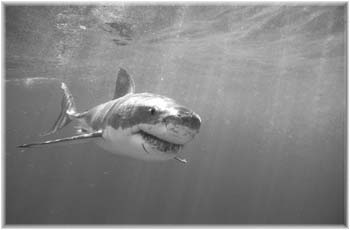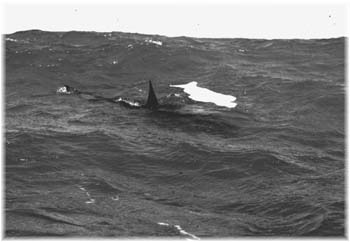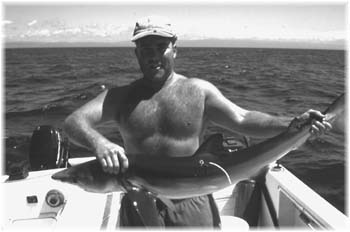 | |||||||||||
|
|
|
|
|
|
|
||||||
|
| |||||||||||
![[Metroactive News&Issues]](nuz-0406_files/metro_logo.gif)
[ Features Index | Metro Santa Cruz | MetroActive Central | Archives ]
A Savage Science
 Carl Roessler Mean or Misunderstood? : Local researchers want to prove that sharks are not man-eaters. A new electronic device will allow a first-ever study of their behavior. Sharks' mysteries probed in new Año Nuevo study By Robert Struckman AT LOW TIDE IN MID-AFTERNOON at Point Año Nuevo, the barking of the elephant seals is deafening. One half-ton, 12-foot-long bull slides onto the shore with the aid of a small wave, then undulates up the beach on top of a warm, smelly bed of kelp, kicking up a swarm of flies and beach-hoppers and disturbing a small flock of sandpipers. The elephant seal wiggles its tremendous body into the wrack, finds a comfortable position and rolls onto its side. An ocean breeze carries the barking of the seals and sea lions over from Año Nuevo Island. Thousands can be seen on the rocky shore, some perched with their heads raised, others slipping in and out of the water. This area is the most significant rookery for harbor seals, sea lions and elephant seals in Northern California. Along the West Coast from Mexico to Alaska, only a few places have larger sea mammal populations. The point and island are rife with sloping rocks and sandy beaches--protected by cliffs and state law from land-based predators. Upwelling currents bring food from the ocean floor. The combination creates a perfect environment for pinnipeds--the suborder of aquatic carnivores with their four limbs modified into flippers. All of this noisy blubber also makes Año Nuevo a great place for sharks. It's like a fast- food restaurant for great whites. "They just swing by and pick up a meal," says Sean Van Sommeran, director of the Pelagic Shark Research Foundation. Out past the island last January, Van Sommeran and David Casper, a veterinarian at UCSC and board member of the Pelagic Foundation, sailed to the Año Nuevo area to scout for sharks. As they arrived, they saw the floating, bloody carcass of a 1,000-pound elephant seal. A great white had just killed the creature. They cut the engines and floated close to the carcass. A long shadow passed beneath. A boil of water marred the surface. "It looked like the shark was feeding about every 30 seconds," Casper says. The two had brought tags on the off chance that they would see a great white and then be able to get within eight feet of it, an event which is extremely rare and dangerous. Suddenly Van Sommeran and Crisp found themselves in the presence of a shark that was "as big as a Buick and not too worried about anything," Casper says. Van Sommeran was able to tag the shark while it was happily gorging itself. Then the two were shocked to see that a second great white was there. They tagged it, too. By the end of the day, the two tagged four sharks feeding on that carcass. None of them expected that kind of behavior from great whites. That's because no one--even scientists--knows much about sharks. A new study that will be centered at Año Nuevo could go a long way toward changing that situation. With an electronic device that will be employed for the first time, sharks will be monitored in the same way that bears, mountain lions and wolves have been for years.
Fin de Siècle: A great white trolls the North Coast--but not for human flesh, say researchers. Love Bites A RESEARCHER AT FLORIDA'S International Shark Attack Files recently expressed a new theory: some attacks on humans may be sexual in nature. Of course, from the point of view of the object of the shark's advances, it may not feel terribly amorous. This odd theory results from the study of the marks sharks leave on their victims. Shark experts all over the world have seen heavy scarring on a female's fins or tail from bites, presumably, by male sharks in what could be sexual circumstances. According to this theory, the male great white affectionately rakes its teeth across the female's tail. During several recorded attacks on humans, great whites have inflicted similar raking bites. Van Sommeran and numerous other experts discount that idea. "That's worse than simple conjecture," Van Sommeran says. "Other theories are more likely: that shark attacks are simply curiosity attacks. A shark will 'mouth' or scrape a person to break the skin's seal, and then retreat to sniff the blood. We have sometimes seemed to draw the same nudging and raking reaction to a surfboard or buoy. But I don't think in any circumstance the inanimate object actually fooled the shark, at least not so far that the shark would mistake a person for another shark." No one really knows. Little is known about how great whites hunt or mate, if they are territorial, or how far they migrate, if indeed they do. There aren't even clear ideas of their numbers, though some scientists fear that they may be endangered. Carcharodon carcharias, as great whites are known to biologists, can be found in temperate waters across the globe. On 158 known occasions, they have attacked people. About a quarter of those people died. The number of the shark attacks has increased over the last century, according to George Burgess of the Florida-based Shark Attack File. But attacks are still astronomically rare, Burgess says. The majority of knowledge about white sharks is anecdotal and is centered on those rare attacks. The result is the pervasive idea that sharks are senseless, mechanical killing machines. But new research suggests a much more complicated creature. Great white sharks have remained unchanged for at least 60 million years. They are one of the world's oldest predators. They are ancient animals, much older than dinosaurs and eons older than newfangled modern creatures like mammals. As old as the species is, sharks possess highly evolved senses. They can feel disturbances in water from a mile away, and can hear the splashing of a seal's dive, reports one scientific study, at great distances. No predator on earth can match a shark in size and strength. But new evidence seems to show that they don't always like a fight. One study reports that they seem to like to minimize conflict when hunting. In fact, A. Peter Klimley, head shark researcher at the Bodega Bay Marine Laboratory, found that sharks will never fight over a seal's carcass. Videos have captured repeated incidents of sharks vying for a carcass. Instead of fighting, they swim toward each other from opposite directions. As they pass, they lift their tail and slap the surface. The shark that makes the biggest splash takes the meal. "But that's not to say that a shark isn't a killing machine. When a shark says, 'I'm gonna eat this and kill this,' the shark will do just that," Van Sommeran says. Nevertheless, Van Sommeran says, the popular conception of sharks is false. "All of the great white's nicknames--White Death, Man-Eater--are just plain wrong."
Blue Water, White Flesh: Sean Van Sommeran of the Pelagic Shark Research Foundation shows off a blue shark beauty caught near Año Nuevo. The fish will be tagged, not eaten. The Superpredator THE SUMMER BEFORE MY senior year in high school in Montana in 1989, in the clear brightness of late morning in the wilderness, I saw what I initially took to be an oversized dog jogging sideways on a bare ridge across from me. It was brown-gray and at least 300 yards away. But in that crisp, thin mountain air it had such a hugeness to it that I stopped and stared. The wolf stopped, too, and turned its broad head toward me. My skin prickled all over my body. I stood, scared and excited. "It sees me," I thought. "Oh, my God." Van Sommeran laughs in appreciation. "Imagine a predator that hunts wolves and grizzlies. That's a great white shark," he says. "Elephant seals are alpha predators in the sea. They can easily weigh a thousand pounds." A full-grown great white can bite an elephant seal in half. Van Sommeran knows his subject. Born and raised in Santa Cruz, he witnessed two white shark feeding events by the time he was in his teens--one out by Año Nuevo and another near the Farallons. His life seems formed by shark research. Van Sommeran worked extensively on the first generation of shark research in cooperation with Klimley. (When the Bodega Bay shark researcher's name is mentioned, Van Sommeran instantly says, "My hero." In explanation, he says that Klimley is "the wacky, genius professor, the patriarch of great white sharks.") Shark experts across the nation agree that Klimley has pioneered the scientific study of great whites. His research revealed the hunting technique of great whites. The attacks begin with the shark swimming upward from the deep at speeds of up to 30 miles per hour, striking its prey with such tremendous force, it sometimes knocks the sea lion or seal clear out of the water. The blow usually stuns the prey. In some cases, the shark then pulls the seal down into the water and lets it drift, bleeding, to the surface, apparently to allow the animal to bleed to death to minimize struggle. White sharks almost never were observed to release a seal or sea lion without removing a bite. Once, however, Klimley recorded a fortunate man who was attacked and let go. M. Tisserand's attack was P-99. According to a table of predatory attacks in which the prey was not immediately eaten, Tisserand said, "The shark came up from underneath. It carried me ... pulling me down ... for five to seven seconds. The shark suddenly let go and swam off." A carnivore that powerful inspires passion in people. Many surfers almost worship great whites, while some coastal inhabitants want to conquer the animal and kill it. Meanwhile, the world's most powerful predator may be very susceptible to overfishing and environmental toxins. Great whites appear to have dwindled significantly on the East Coast from hunters going after their jaws and teeth as souvenirs and trophies. A medium jaw set of a great white shark was on sale in 1993 for $8,000 in Miami. Experts agree that the great white's place at the top of the food chain make it uniquely vulnerable. "Some animals are grazing animals," Casper says, "and there's always bazillions of them. Their populations expand when food and conditions are good and contract when they're not. By nature predators are much fewer than what they prey on. With the case of sharks, you're talking about a predator that's way on top of the heap." Shark experts from South Africa, Australia and the U.S. East Coast say a few years of overfishing have depleted the shark population. And, again, nobody knows how long it will take for the great whites to recover. Great White Fever IN ABOUT A MONTH, BURNEY LeBoeuf, a pinniped expert at UCSC, and Klimley will begin further study, funded by UC-Davis and the National Science Foundation, of great whites and elephant seals near Año Nuevo. Klimley wants to find out how sharks mate and further his studies about how they hunt. LeBoeuf is interested in the way that seals, sea lions, and elephant seals evade sharks and defend themselves. In a previous study, LeBoeuf attached underwater cameras to the heads of elephant seals with epoxy. The cameras came off after six months when the elephant seals molted. The scientists hope to learn whether or not the sharks are territorial and how their families work. They also hope to get the first bits of information about how sharks mate and give birth, and to conduct the first study tracking the migration of great whites. To do that, 20 transmitters will be attached to great whites and elephant seals. The tracking will be done with a light-sensitive meter attached to the fish. By tracking the rising and setting of the sun, the meters will be able to locate great whites anywhere in the ocean within a few nautical miles. A physicist working with Klimley says that the tracking devices on sharks in the past have not been accurate. Previously, errors were made when a shark dove so deep that the filtered light was dim enough to fool the sensor into thinking the sun had set. The Pelagic Foundation has enjoyed surprising success near Año Nuevo. They have tagged a total of 12 great whites this year, a national record, Van Sommeran says. The foundation's office is a small, cluttered space above a yacht repair store at the Santa Cruz harbor. The walls are covered with posters. The place is crammed with navigational and sailing equipment. In the office, Callaghan Fritz-Cope, a photographer and Pelagic crew member, says he hopes to take part in the study. He's new to Pelagic. He's been taking pictures for the outfit since January. But, like Van Sommeran, he's got a full-blown case of shark fever. He rummages through some stacks of old photographs. "Welcome to the Pelagic filing system," he says, picking up a pile of slides and papers from the floor. When he's done, he sits down on an old couch against the office's rear wall. He's smiling about the thought that he may soon be spending every minute of his days on the water near Año Nuevo, taking pictures of sharks or just helping the scientists, however he can, answer the shark questions. "It's just about shark season," he says." In the beginning of October the gun will go off, and it'll be Año, Año, Año ... all day and every day."
| ||||||||||||||||||||||||||||||
From the Sept. 10-17, 1997 issue of Metro Santa Cruz.
Copyright © Metro Publishing Inc. Maintained by Boulevards New Media.

